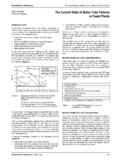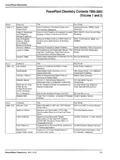Transcription of The Mechanism of Action of Isothiazolone Biocides
1 Terry M. WilliamsABSTRACTI sothiazolone Biocides have proven efficacy and per-formance for microbial control in a variety of industrialwater treatment applications. Understanding themechanism of Action of industrial Biocides is importantin optimizing their use and combating resistance ifencountered. Isothiazolones utilize a two-step mecha-nism involving rapid inhibition (minutes) of growth andmetabolism, followed by irreversible cell damageresulting in loss of viability (hours). Cells are inhibitedby disruption of the metabolic pathways involvingdehydrogenase enzymes. Critical physiological func-tions are rapidly inhibited in microbes, includinggrowth, respiration (oxygen consumption), and energygeneration (adenosine triphosphate synthesis). Celldeath results from the destruction of protein thiols andproduction of free radicals. The rate and extent ofkilling may be enhanced by various adjuvants includingsurfactants.
2 This unique Mechanism results in a broadspectrum of activity, low use levels, and difficulty inattaining resistance. INTRODUCTIONI sothiazolone Biocides are widely used in a variety ofindustrial water treatment applications for control of micro-bial growth and biofouling [1]. The most frequently usedproduct is a 3:1 ratio of 5-chloro-2-methyl-4-isothiazolin-3-one (CMIT) and 2-methyl-4-isothiazolin-3-one (MIT).CMIT/MIT has broad spectrum efficacy versus bacteria,algae, and fungi. 1,2-benzisothiazolin-3-one (BIT) productshave been used in a limited range of industrial applicationsrequiring long-term preservation for bacterial control,including mineral processing and closed loop cooling sys-tems. Recently, a new microemulsion technology wasintroduced using 4,5-dichloro-2-n-octyl-4-isothiazolin-3- one (DCOIT) as an algicide for cooling water treatment anda fungicide for paper mill applications [2].
3 The most recentisothiazolone biocide for industrial water systems is basedon the MIT active ingredient alone and is targeted at long-term preservative applications with higher pH and tem-perature the mode of Action of industrial Biocides isimportant in optimizing their use and combating resistanceif encountered [3]. The antimicrobial effects of isothia-zolone Biocides have been broadly defined for CMIT andBIT [1,3 11]. These Biocides function as electrophilicagents, reacting with critical enzymes to inhibit growth andmetabolism, with cell death occurring after several hourscontact. Less is known about the Mechanism of MIT andDCOIT. Oxidizers also function as electrophiles, with rapidspeed of killing, whereas quats and other membraneactive agents tend to directly affect cell membranes(Figure1) [3].The intent of this paper is to review the Mechanism ofaction of Isothiazolone Biocides across a range of microor-ganisms, including cell binding, inhibition of growth andrespiration, interaction with proteins and enzymes, andsubsequent loss of viability (cell death).
4 The impact of themechanism will be discussed relative to monitoring effi-cacy, resistance and ways to improve their AND METHODSB iocides EvaluatedThe chemical structures of the Isothiazolone biocidesdescribed in this paper are shown in Figure2. CMIT/MITis composed of a 3:1 ratio of CMIT:MIT at a final concen-tration of active ingredient (ai).(1)DCOIT is for-mulated at a concentration of ingredient in awater-based microemulsion.(2)MIT biocide is a solution in water.(3)OIT biocide is a 5%active solu-The Mechanism of Action of Isothiazolone Biocides 2007 by PowerPlantChemistry GmbH. All rights Mechanism of Action of Isothiazolone Biocides14 powerplant chemistry 2007, 9(1)(1)Kathon WT Microbicide (Rohm and Haas Company;Philadelphia, PA)(2)Klarix 4000 Microbicide (Rohm and Haas Company;Philadelphia, PA)(3)Kordek MLX Microbicide (Rohm and Haas Company;Philadelphia, PA)Figure 1: Mechanism of Action of industrial ,2-dibromo-2-cyanoacetamideBNPD2-bromo-2 -nitropropane-1,3-diolThe Mechanism of Action of Isothiazolone Biocides15 powerplant chemistry 2007, 9(1)tion in propylene glycol and was included for biocide concentrations in this paper are reported on anactive ingredient basis.
5 The Isothiazolone Biocides de-scribed in this paper are manufactured by Rohm and HaasCompany. Solutions of CMIT and MIT were prepared indistilled water and kept frozen until use. DCOIT and OITwere diluted in 50:50 (v:v) ethanol:water. All other chemi-cals used were reagent grade or the highest availablepurity, and most were obtained from Sigma ChemicalCompany, St. Louis, MO, unless stated and Culture ConditionsPure cultures were obtained from the American TypeCultureCollection (ATCC, Rockville, MD, USA). Sac-charomyces cerevisiaeATCC 4921, Aspergillus nigerATCC6275, and Pseudomonas aeruginosaATCC 13388 weregrown in Sabouraud's dextrose broth (SDB), potato dex-trose broth (PDB), and M9G minimal salts media with glu-cose at 30 C, respectively [4]. Escherichia coliATCC25922 and Pseudomonas aeruginosaATCC 15442 werealso obtained from ATCC and were routinely grown in M9 Gmedia.
6 Cultures were incubated at 37 C (E. coli) or 30 C(P. aeruginosa).Transport and Binding of Isothiazolone Biocides withS. CerevisiaeCellsCell binding studies were conducted to determine theassociation of the Isothiazolone biocide with microbialcells. Chemostat-grown cells of S. cerevisiaewereused in these studies in the presence of CMIT, MIT,and DCOIT Biocides . Cells were treated with radio-labeled biocide and radioactivity levels were usedto determine the uptake of the biocide into cultures were grown in New BrunswickScientific BioFlow chemostats at 30 C and an agi-tation rate of 100 revolutions per minute. S. cere-visiaewas grown in SDB + % glucose at a gen-eration rate of h. Cells were harvested in sterile50 mL Oak Ridge tubes, washed, and resus-pended to an absorbance (660 nm) of in10 mM PO4buffer (pH ). Samples were frozenand protein content was was determined using the Bio-Rad auto-mated microassay in 96-well microplates using theBiomek 2000 Workstation.
7 The plates were incu-bated at room temperature for 5 to 60 density (OD) at 650 nm was measuredusing a Molecular Devices Thermomax MicroPlateReader. Data was analyzed using the MolecularDevices SoftMax of Growth Inhibition and SusceptibilityThe lowest concentration of biocide required to inhibitgrowth was determined by a high resolution minimuminhibitory concentration (MIC) test. Varying amounts of thetest compound were added to media in a 96-well micro-titer plate. Ten-fold serial dilutions were performed on aBiomek 2000 Workstation to obtain a range of closelyspaced concentrations. A cell suspension, adjusted toprovide 106colony forming units (cfu) per ml in each well,was added to the microtiter plate. Microtiter plates wereincubated at 30 C for 48 h and then were checked for thepresence or absence of growth in each well. The concen-tration of compound in the first microtiter well demonstrat-ing no growth was the MIC for the test biocidal concentrations (MBCs) were determinedby transferring an aliquot from the MIC plates to trypticasesoy broth (TSB) media containing mL 1sodiumthioglycolate to neutralize the remaining biocide.
8 The low-est concentration of biocide in which no survivors wererecovered was defined as the MBC. Data reported are theaverage of multiple determinations the standard response of Escherichia coli(ATCC 25922) to CMIT inhibition, over the course of the growth cycle, was deter-mined by following increases in absorbance (turbidity) ofthe culture at 660nm at 37 C in M9G media. Biocide wasadded to the culture and growth measured in the presenceof and mg kg 1 CMIT. Control samples containedno 2: Chemical structure of Isothiazolone chemistry 2007, 9(1)The Mechanism of Action of Isothiazolone BiocidesEffects on Microbial Respiration (Oxygen Uptake)Respiration in E. coliwas measured using a polarographicelectrode. Cells were grown overnight in M9G medium,diluted 1:50 into fresh M9G and allowed to grow to anabsorbance of at 660 nm. The cultures were washed inglucose-free M9G, resuspended to the same density inglucose-free M9G, and incubated 2 h at 37 C to depletethe cells of endogenous carbon reserves.
9 The absorbancewas readjusted to absorbance units at 660 nm. Theassay was performed on 2 mL aliquots placed in a waterjacketed steel chamber equipped with a Clark oxygenelectrode (Hansatech LTD, Norfolk, UK). Substrate (glu-cose) was added to the sealed chamber to a final concen-tration of 10 mM, and biocide (134 M) was added after asteady rate of oxygen consumption was reached (generallywithin 2min).Effects on ATP SynthesisATP (adenosine triphosphate) was determined by theluciferin-luciferase reaction using a Turner 20DE Lumino-meter and the Sigma Luciferase Kit (Sigma Chemicals). Amid-log phase culture of E. coligrown in M9G media wasdiluted 1:2 into fresh M9G media pre-warmed to 37 culture was divided into 25mL subcultures and placedin a shaking water bath at 200 revolutions per minute and37 C. The cultures were allowed to equilibrate, with500 Lsamples removed every 5min.
10 One culturereceived 5 g mL 1final concentration CMIT and the otherreceived an equal volume of sterile water. Over time,500 L aliquots were removed, added to 100 L MHNO3, vortexed, and allowed to sit on ice for 5min. Thesamples were then diluted into mL of M Tris(hydroxymethyl)-aminomethane-HCl (Tris-HCI), pH ,and mixed. A 50 L sample was placed in the ATP assaytube along with 50 L of assay mix. The assays were initi-ated by the injection of 5 L aliquots of a 1:10 dilution ofthe luciferase enzyme. Peak luminosity values wererecorded, and compared to a standard curve constructedin spiked cell extracts. Control experiments demonstratedthat high levels of CMIT did not inhibit the luciferase Inhibition of Yeast AlcoholDehydrogenaseAlcohol dehydrogenase (ADH) was assayed according toVallee and Hoch [12]. In this method, the reduction ofnicotinamide adenine dinucleotide (NAD) to NADH was fol-lowed by measuring absorbance of the reaction mixture at340 nm.

